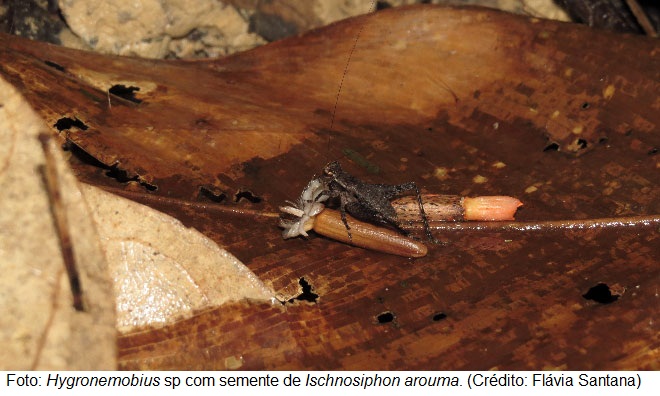Languages
Seed Dispersal by Nocturnal Crickets.
In addition to being great at singing nocturnal crickets are also important seed dispersers!
A large proportion of seed dispersal in tropical forests is performed by iconic vertebrates such as birds, bats, monkeys and rodents.

But the silence of the day, between the leaf litter of the forest, humble ants also do this work. And very well! His throne as the main dispersers of invertebrates had not been challenged until now. The new study "Busy Nights: High Seed Dispersal by Crickets in the Neotropical Forest" has just been published in the journal The American Naturalist this study, the authors demonstrated the important role of crickets as ground herbs seed dispersers They are.. drawn by the same type of oil seeds by ants:. arillated seeds, which means seeds with an attached fleshy part which is consumed by the animal without damaging the seed "We show that, compared to the ants, crickets remove seeds in similar amounts and tend even to carry heavier seeds over longer distances, "said Flavia Santana, PPG-Ecology of INPA and an author of the work Now you might ask. if crickets are dispersers so visible, because people did not know this before ? the study also showed that the performance of the crickets in the removal of seeds occurs mostly at night, while most of the seed dispersal studies are conducted during the day, suggesting that this may be the reason why the seed dispersal of crickets has It has been neglected. The new window opened by the study is full of unresolved issues: the nights are busy with dispersion crickets everywhere? All crickets are able to disperse seeds? What kinds of plants are benefited by dispersal crickets? What is attracting crickets to arillated seeds? The study was conducted in RAPELD grid portions of the Ducke Reserve and benefited from previous studies of terrestrial herbs, ants and crickets to resolve the taxonomy of the species involved.
Researchers Fabricio Baccaro and Flavia Costa, both of INCT-CENBAM also signed the study, which can be accessed at:http://www.amnat.org/an/newpapers/NovSantana.html.
Text: Flávia Santana, Flávia Costa e Rafael Rabelo

